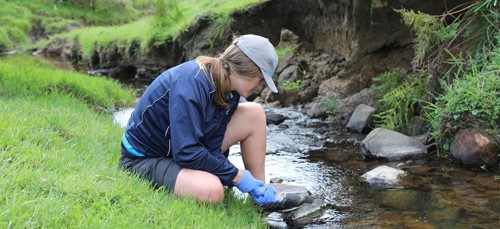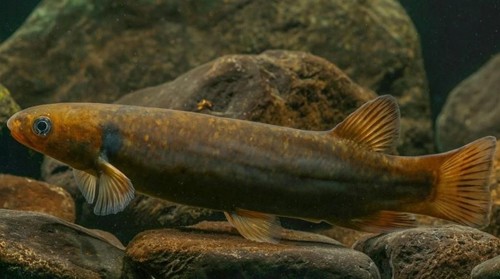

Project to support Ohiwa Harbour’s waterways reveals at-risk indigenous fish species
A project to improve connectivity between the waterways around the Ōhiwa Harbour, and increase freshwater fish populations, has uncovered the presence of threatened and at-risk indigenous species.
The Ōhiwa Fish Passage Project is a multi-year project working to gain a greater understanding of what indigenous freshwater fish species are present in the rivers and streams and identify ways to support their ongoing survival by reducing barriers in the water that may hinder their lifecycle.
Bay of Plenty Regional Council Land Management Officer, Tim Senior, says New Zealand’s indigenous freshwater fish present a unique challenge as they are diadromous (travel between saltwater and freshwater as part of their lifecycle), so structures in rivers and streams can delay or prevent fish movements to and from the sea.
“There are a range of instream structures, such as culverts, dams and weirs," he says. “These can create physical obstructions or create conditions in the stream or river that can hinder a fish’s journey.
“It doesn’t have to fully block the passage to be a problem either. If something slows a fish down, makes them expend more energy or poses a risk to injury or predation, it is having an impact on fish health and, therefore, fish populations.
“Over time, these structures have resulted in a reduction in the distribution and abundance of some of our most iconic and valued freshwater species. This project seeks to make changes that will support the recovery of indigenous freshwater fish populations.”
The project began with a computer-based mapping exercise, which revealed there are more than 500 instream structures throughout the Ōhiwa Harbour area.
Over the past year, the Regional Council has been carrying out physical assessments of these structures. This involves looking at its physical condition, comparing this to the environment on either side of a structure, and assessing if these conditions are likely to pose a challenge to the movement of fish.
Instream structures that are assessed as posing a challenge are eligible for remediation. Remediation involves the Regional Council identifying what makes the structure challenging to fish and working with landowners to find solutions to reduce or alleviate the fish passage barrier.
Environmental Scientist, Erin Fox, says it could be as simple as installing a ramp to reduce the drop coming out of an outlet, or putting baffles inside a structure to slow the water, creating diverse flows so the fish have somewhere to rest.
"This remediation work is done at no cost to the landowner.”
As well as instream structure assessment, the Regional Council is carrying out environmental DNA (eDNA) testing at 20 locations in the Ōhiwa Harbour area, to understand what indigenous freshwater fish are there and where they are.
eDNA testing is a method that collects DNA material (such as waste or lost scales) from water samples through a filtration process. The filters with the DNA material are then processed by a specialist laboratory in Wellington, which provides a list of what species are present in that sample (including fish, plants and animals).

Environmental scientist Erin Fox undertaking eDNA testing.
Erin says the monitoring has already returned some exciting results – including new species detections for the area and a greater understanding of the distribution of remaining fish populations.
“We now know there are at least 14 indigenous freshwater fish species in the area, including the shortjaw kokopu, which is a threatened species under the New Zealand Threat Classification System, and the giant kokopu, which we haven’t previously detected.
“The tests also picked up shortfin and longfin eel (tuna), which are considered taonga in Māori culture and, in addition to the fish species, kakahi (freshwater mussels) were detected.
“The detection of kakahi is exciting as these are a threatened species. They are a good indicator of an ecosystem’s quality because they require clean water and a riverbed that is not too silty. They may also contribute to its health through biofiltration (filtering out particles and nutrients from the water).”
Erin says for some species, the detection in the samples is quite low, which suggests that populations are small.
“This is something we would be closely monitoring as we carry out remediation work to improve fish passage, to see if the detection in the samples increases with improved connectivity.”

Shortjaw kokopu (Galaxias postvectis) is a threatened species.
As most of the survey and testing sites are on private land, the success of this project relies heavily on landowner support, which Erin says has been hugely positive.
“Fish are a key indicator for a healthy waterway, and the core of the project is ensuring their ongoing presence in the catchment by making sure that they can get to where they need to go, when they need to go, and that their habitat is in a reasonable state.
“The Ōhiwa community is really interested in what lives in their waterways, and we’ve had some good discussions about the life of freshwater fish and why they are an important part of our ecosystems.
“As well as remediating the fish passage barriers, we’ve had conversations with landowners about helping improve the habitat for fish on their property more generally too, for example by fencing and planting waterways on their land.”
This project gives effect to one of the actions in the Ōhiwa Harbour Strategy, a plan developed by the seven partner organisations that make up the Ōhiwa Harbour Implementation Forum: Bay of Plenty Regional Council, Ōpōtiki District Council, Te Runanga o Ngāti Awa, Te Upokorehe, Waimana Kaaku - Ngāi Tūhoe, Whakatāne District Council and Te Whakatōhea.
Learn more about this project via the Regional Council website
For further media information, please contact Laura Boucher at media@boprc.govt.nz
